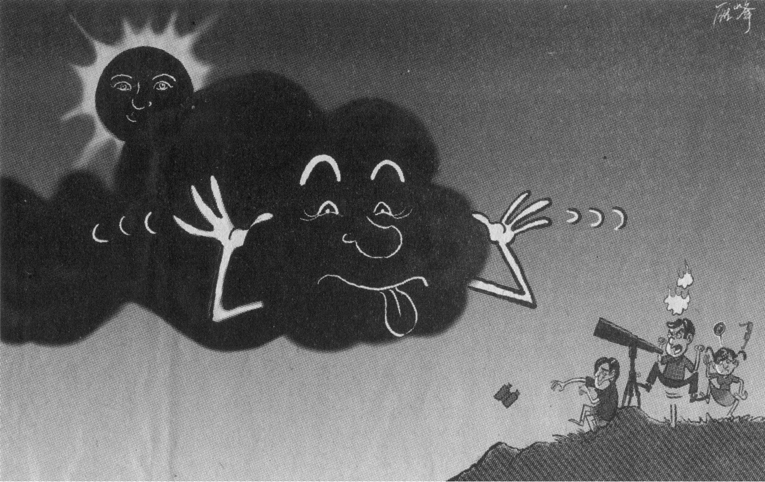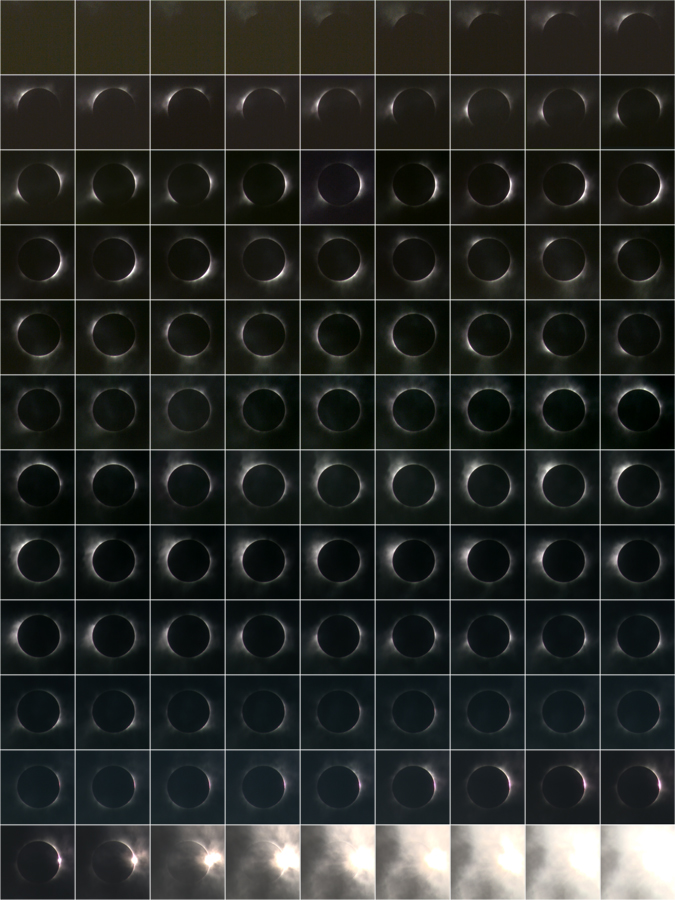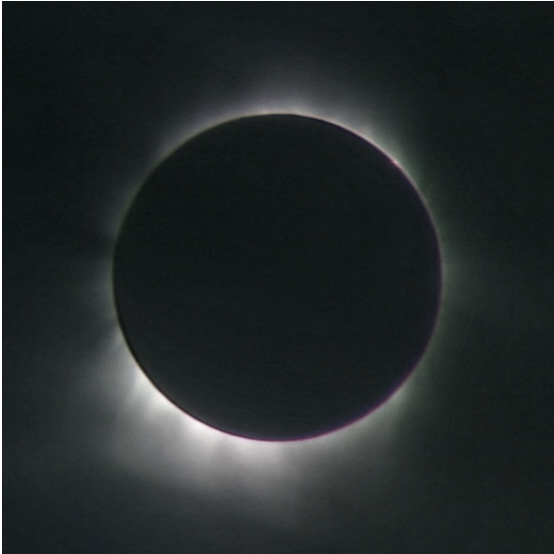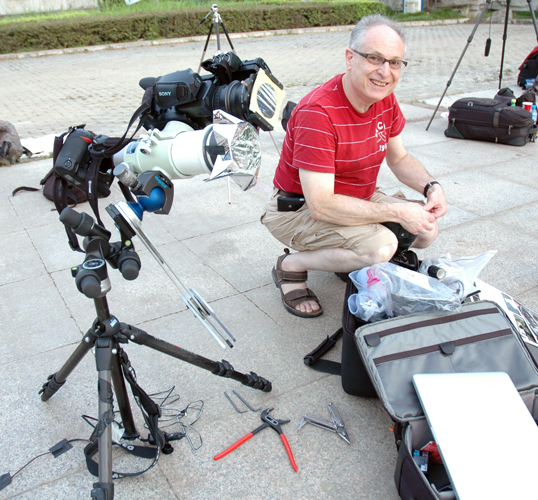For TSE2009, Joel Moskowitz and I with
Rick Brown's eclipse chaser's group set up on the WBI quad, right at
the location of the "dark stain" at the right of the bottom photograph
(taken a year before TSE2009 by Rick Brown, looking
east toward the direction of the to-be-eclipsed Sun; north is to the
left) is at the GPS measured (WGS84) geographical coordinates noted
above.
From this location we had anticipated,
and planned for, 5m 29.6 of totality predicated upon the predicted
local eclipse circumstances as follows:
|
Wuhan
Bioengineering Institute Eclipse Site
Local
Eclipse Circumstances
EVENT UNIVERSAL TIME SUN ALT.
C1: 00h 15m 10.2s +32.6°
C2: 01h 24m 14.4s +47.5°
Mid: 01h 26m 59.2s +48.1°
C3: 01h 29m 44.0s +48.7°
C4: 02h 46m 49.3s +64.9°
Penumbral Duration: 2h 31m 39.1s
Umbra Duration: 5m 29.6s
Magnitude: 1.035
Lunar Limb Profile
Corrections
Applied
Atmospheric Refraction
Corrections Applied
Ephemerides: LE/DE 406
Delta-T = +66.448s
C.O.M to C.O.F Offset
= (+0.50”,-0.25”)
|
But, we saw "only" approximately 94
seconds. I say "only", in quotes,
because this alone was still very significantly longer than five of the
(27) earlier times I have been enveloped by the lunar umbra: (
1977
[38s],
1986
[0 to 5 seconds depending upon how defined and measured],
1995
[57s],
2002
[26s], and
2005
[32s]). Indeed, it is a sobering thought that the amount of
totality we saw of TSE2009 was essentially equal to that experienced in
total from 4 of those 5 aforementioned eclipses! The disparity
between the ~ 5m 30s of totality predicted and the ~ 94 s we saw,
however, was not because our eclipse predictions
were off the mark (they were not!), but rather for this reason as so
well captured in
Chinese newspapers the day after the eclipse:

But note, despite the (perhaps
somewhat over-embellished) reactions of the
cartoon observers being initially much like our own, the eclipsed Sun
for us was still partially visible during
totality. And thus, for us at WBI, TSE2009 became the totality for
which for
which the glass was 1/4 full rather than 3/4 empty.
From our site at the WBI, happily, some coronal photons did make it
through the
shifting clouds, contiguously for the last minute and a half plus of
totality (see below), thus enabling a partial victory snatched from the
jaws
of a cloudy defeat.
The day before the eclipse we had assessed
the weather situation with other like-minded and weather-causality
savvy umbraphiles Jay Friedland and Roland Burley while at the Wuhan
airport -- with in part an advanced option in mind to relocate eastward
to Shanghai, or westward to Chongquin, by commercial air if needed to
gain an advantage. (It was particularly welcome to have Roland, a
747 pilot for Cathey Pacific Airlines who lives in China, with
first-hand insights into
the local weather in the loop - thanks Roland). But to all of us, it
was
readily clear (or, I should say
apparent)
that Shanghai and environs was best avoided and we anticipated (at
least some) eclipse-chasers relocating in our direction. There
did not seem to be any unambiguous advantage for Chongquin over Wuhan
or vice versa. So, we decided to stay put for that moment
but keep a continuous eye on the weather with later local relocation
possibilities using the chartered busses Rick had arranged for.
"Last minute" dashes to out run fronts or find holes in cloud cover (as
I have before done when meaningfully informed, e.g.,
TSE1976,
TSE1979
and
TSE1997)
did not apply.
Over the entire Wuhan region of short time-scale relocatability, the
local
cloud conditions after sunrise were spatially variable and quite broken
on small scales as noted in situ and with satellite imagery.
Indicators of potential advantage with relocation were not
strong (that perhaps an understatement) and a decision for pro-active
relocation was not well constrained. Without the benefit of
post-eclipse hindsight, given all a priori indicators available, such
action could easily have made things worse, rather than better.
It was, in the end, despite all informed eyes on the weather,
significantly the luck of the draw. Solar visibility varied
on distance scales of kilometers or less and timescales of at most
minutes (and often seconds).
In the prophetic words of
Mel
Brook's "Twelve Chairs" theme, though day-after informed history
might
(unreasonably) suggest otherwise, as totality approached we did "hope
for the best, expect the worst". And, for better or worse, we
were rewarded with less than complete success, by no means suffered
a complete failure.
My autonomous photographic plans for
totality were centered on using
the same 1.2 meter EFL f/12, coelestat-fed, eclipse camera (under
UMBRAPHILE
control), aka my "
lug-a-scope",
that I had used several times before (see below) in only slightly
different incarnations, e.g. recently for TSE
2006,
2002,
and
2001.
The "plan" was to use, for the penultimate time in the remainder of my
eclipse chasing life, my absolute favorite film for TSEs: Kodachrome
25P
(sadly now, like all other now
discontinued
Kodachrome films, as prophetically lamented by Paul Simon
*, destined for
extinction in Dec.
2010). The presence of partially obscuring (but often not
fully
opaque) cloud during the partial phase of eclipse ingress, made me
switch out to a somewhat faster Kodachrome 64. But, in the end, still
not fast enough to meaningfully capture totality as the long(est)
exposures were pre-programmed to be taken at mid-eclipse, a time at
which the clouds were fully veiling the view of totality.

The 1.2 meter EFL eclipse camera (4"
objective lens obscured) pointed at the tracking coelestat and aligned
on the Sun about half an hour before totality. Note the presence,
then, of only diffuse and low-contrast shadows -- the
clouds at that instant acting as a nearly perfect optical density 5
filter
for the partial eclipse in progress! Joel Moskowitz (red shirt),
my daughter Maia (yellow shirt) and myself (checking computer
operations) all hopefully adorned with dominant-eye eyepatches for dark
adaption.
UNFORTUNATELY... The first 4 minutes
of totality were completely obscured by clouds! A bit past
mid-eclipse I sat down on the ground still with a small glimmer of
hope, but nonetheless feeling dejected (my daughter says I was crying,
but I stoically
maintain it was just sweat dripping from the heat and humidity; sniff,
sniff...). But then,
about 94 seconds before C3 there was a tiny brightening in the sky
and... a small "hole" and coronal photons were pouring through into our
eyeballs, with increasing brightness over time - with astonished shouts
of "THERE IT IS", etc.
Actually, I should specifically say
INNER coronal photons, as the remaining clouds were dense enough
(unfortunately) to
obscure the mid and outer corona. But over the next minute and a
half -- with thin wafting clouds -- we saw totality! Not the
"clear sky"
totality we had wished for, but an ethereal totality
nonetheless. The inner corona was viewed for about
a minute and a half through those sparse and flowing clouds, followed
by a
beautiful chromospheric arc just before third contact, and a glorious
3rd contact diamond ring. Below is a wide-field photo taken by Geoff
Simms
who was set up very close to me that illustrates the situation soon
after the eclipsed Sun partially broke through the rapidly moving
clouds.

The broken wafting clouds over WBI gave us partially obscured, but
contiguous, views of the totality in the last minute and a half before
third contact, as captured in this dramatic photograph by
Geoff
Simms (
click on the picture to
see at a larger image scale and higher resolution). Note
the chromospheric light illuminating the clouds toward the ESE
(right). Also note
the "hole" in the clouds to the south (right of the Sun). If only
we had been shifted a couple of kilometers over...
When the Clouds Parted —
Second-by-Second

Click on image mosic above to
see a larger version.
How much totality did we see? That is somewhat subjective. The
lunar limb (or at least a part of it) was clearly seen in
silhouette against the corona at least 94 seconds before 3rd contact -
which is my estimation, but I'll let you decide. The above
matrix of 1 second cadence images of totality (time increasing top left
to lower right, nine seconds per row, north to the right in each frame)
begins 100 seconds before third contact (bottom left image at
01:29:44 UT with the onset of the 3rd contact diamond ring).
|
WHAT
WE SAW!
The density of the clouds was incompatible (as anticipated)
with the pre-programmed exposure sequence I had planned for my
lug-a-scope (with relatively
low speed film and slow f/ ratio) – so, unfortunately, no pictures of
any use from that high resolution camera. But, Joel Moskowitz kept his
HD
video
camera (see below) running and adjusted to a higher gain and
sensitivity (with
readout noise penalty -- but no choice!) and captured what we saw
(though not quite as the eye perceived it).
Click HERE to see a
low-resolution, but full frame, copy of Joel's HD video.
| You
can see a full-resolution
version of the HD movie, but with just the region (of interest)
around the Sun extracted, by clicking on the (Quicktime) movie icon to
the right (in yellow frame). WARNING:
This is a 709
Mbyte file (long download time, but worth waiting for).
Here, I have done some global brightness and contrast stretching (same
to all frames; x1.35 brightness, x2 contrast) to modestly enhance
coronal
visibility in the presence of obscuring clouds. The video begins
a
few seconds before the corona first became faintly evident. From
about 10 to 25 seconds into the video the image becomes "shaky"
as Joel
manually adjusted the camera's aperture (16 seconds into the video a
sudden change in brightness is seen as a result). |

Original
brightness
and contrast
stretched
Patience
while
it
loads!
Sound
on.
|
The
above HD video very nicely captures the streaming nature of the
foreground clouds (as David Makepeace
called similar clouds in Moganshan: "Misty") - but due to the dominant
low light levels, the signal-to-nose is low, and the individual frames
are relatively "noisy".
TSE2009
"Movie" after Image Processing
I have post-processed the appx 3600 raw frames extracted from the
high-res HD video (above), to create a higher SNR,"time-lapsed" TSE2009
totality movie (replayed in real time, with an effective
processed
inter-frame cadence of 1 second). Click on the movie icon to the
right (in green frame) to view the
image processed movie (a 139 Mbyte
file)
at a real-time cadence and full resolution. Details of the image
processing
are given below.
|
|

Image
Processed
Patience
while
it
loads!
Sound on.
|
| The
individual
post-processed frames contained in the high-resolution
post-processed time-lapse movie, are shown, at low-resolution in
the mosaic to the left. Time proceeds from upper left to lower
right.
The presence of partially obscuring cloud is quite obvious with the
advent of the third contact diamond ring (last row). Click on the
image mosaic to see at higher, but not full (as in the movie),
resolution. |
N.B.
In all three movies, north is toward the right.
Need a QuickTime viewer? Click HERE.
|
INNER
CORONA

By further combining selected post-processed images (e.g., in the above
example using 16 post processed frames from images 60-75 as shown
in the image mosaic), to some degree the rapidly moving clouds can be
partially filtered away -- better revealing some details of the
true inner coronal structure. Additionally in this image,
rotated approximately to the orientation of the Sun as seen from Wuhan
(same as the three single frame images at the top of the page), a (30
degree rotational kernel) low-amplitude azimuthal spatial fiter has
been applied to modestly enhance the visibilty of inner coronal
features.

The HD video of totality was acquired by Joel Moskowitz using a
SONY
PMW-EX1 HD camcorder with a Century Optics 1.6x
teleconverter. The HD camcorder was mounted on a
Nikon DX3 DSLR equipped with a
Takahashi
Sky 90. Both cameras were co-mounted on an
Astrotrac equatorial mount with
image focal plane detectors oriented to place the anticipated long axis
of the corona along the long axes of the sensors. (The automated DX3
imaging program failed, like the "lug-a-scope" program, due to image
underexposure arising from variable cloud cover incompatible with the
pre-programmed UMBRAPHILE imaging sequence).
Summary Details
of Video Image Post-Processing (for those who want to know):
While the clouds of Wuhan, of course, remain the limiting factor in
coronal visibility, with frame-by-frame and inter-image post-processing
of the HD video, I have been able to:
(a) increase the photon SNR in the low-flux regime,
(b) largely mitigate (reduce) noise due to the camera readout
electronics (and/or digital encoding),
(c) improve image contrast,
(d) compensate (or largely so) for sensitivity and color balance
variations with changing cloud opacity,
(e) correct for jitter and image wander when the camera was
being adjusted.
Of course, a basic tenant of
information processing (as well as many other things in the physical
world) may be summarized as “there is no free lunch”. So, all of the
above “improvements” (and I’ll let you judge if they are) have been
done at the expense of temporal sampling -- that is the primary trade
space. With some other trades, to simultaneously realize the
above goals, I found (experimentally) it necessary to make use of the
information in approximately 30 (contiguous) video frames (spanning 1
second in time given the frame rate) to create one “output frame”
representative of a one second, (nominally) 30 image, SNR weighted
median-combined "snapshot". Thus,
the processed “movie” has a cadence of (only) 1 fps, and (thus) is
played as packaged as a QuickTime movie at that rate -- appropriate to
show what we saw of totality in “real time”. I.e., it “looks
like” a time-lapsed movie (or as one would get from a photographic
intervelometer sequence). The original HD movie flows much more
“smoothly” in time. But the processed movie, while much more temporally
discrete, is composed of post-processed frames that are a significant
improvement compared to the individual input HD video frames (see
below).

A representative example of the
improvement in image quality acheived is illustrated by comparing a raw
(but 1.35x brightness, 2x contrast renormalized) HD frame (left, from
1m 32s into the video, just as the chromospheric arc begins to appear)
with a corresponding frame post-processed (right) as described below.
The original movie with a 30 fps cadence, of course, “looks” more
natural in terms of not being a series of discrete pictures and the
"wafting" of the (#*@^&!) misty-clouds is much more "esthetically
pleasing" (in a very ironic way, as we wish they were not there!).
Download the Post-Processed movie from here (same as link above in the
green frame; note: this is a 136 Mbyte QuickTime movie):
Below, I leave out processing details
of minutia, but note the process was a bit painful (or at least time
consuming) because: (a) it was not fully automated in some steps and
(b) also due to the low SNR of the input frames I had to manually
inspected to reject outliers from all appx 3600 frames
individually. In all, only a small number of input frames were
rejected. Most of those were near the beginning of the raw video,
where the cloud density was still extremely high and during times where
Joel was manually handling the camera (leading to image smear within
individual exposures, and changing inter-frame camera sensitivities).
1. Extract image sub-arrays from a fixed region of the HD field
containing the Sun for every video frame – i.e., create 3600 raw image
files (of just the region of interest) for subsequent processing.
2. Examine ("by eye") every individual raw color frame and reject those
that had significant image smear (due to camera handling) or other
artifacts. (Only a very small number were rejected, but
importantly so, so as not to bias later processing).
3. Color separate R, G, B planes of each image into separate files (so
3 x 3600 files input files to process).
4. Quantitatively determine image mis-registrations. Adaptively
cross-correlate sequential frames (separately for R, G, B) to determine
position offsets from image jitter. Combine cross-correlation
results (with SNR weighting) in each color to determine and correct for
image mis-registration (jitter and wander), cross-checked
chi-square minimized image first-differences. This is a variant
of the process I had developed originally for "dejittering" Jay
Friedland's TSE2003 hand-held video. For these interested in
details
SEE
HERE.
5. Correct for image jitter and tracking errors. Register (in X/Y
translation only, not rotation) all images using (4) to a common
reference. Translate via resembling each R, G, B, image
(separately) onto a same-sized output image grid with sinc-apodized
bi-cubic interpolation. (Detail: This (and also step 7) were done using
an IDL-based S/W application package called "idp3", developed by the
NICMOS (Near Infrared Camera and Multi-Object Spectrometer) team for
Hubble Space Telescope image processing - but is widely applicable to
other astronomical image processing). [A couple of papers of possible
interest:
1
(see section 3),
2]
6. Bin into 1-second (nominally 30 frame without outlier rejection)
R,G,B image sets.
7. Combine images with 1 second cadence. Within each 1-second bin
take SNR weighted median combination of (nominally 30) R, G, and B
images to produce a single image in each color (note: this process will
shift color balance in later image recombination since SNR weights are
different in each color).
N. B.:
Special processing (sensitivity compensation) was required for the
1-second bin where the camera sensitivity (aperture) was adjusted while
recording).
8. Create 3-color plane TIFF files from 1-second cadence (R,G,B)
combined images.
9. Linearly re-stretch images (applied equally to all 3 color planes)
to near full scale, 3-sigma, in compensation for the less than (8 bit
per color) dynamic range used (e.g., dynamic range was actually very
low when eclipse first became visible).
10. Adjust inter-frame color balance for color-neutral dispersion and
global distribution (e.g., coronal color shifts toward green with
increasing cloud).
11. Assemble frames into a QT Movie with 1 fps playback and attach
audio track.
CLOSING REMARKS:
1 - We would like to publicly thank Rick Brown for all of the hard and
diligent work he had done over a very long time on all of the
logistical and planning details that made this "eclipse chase" a
success despite the intrusion of somewhat uncooperative weather.
Thanks, Rick, for an unforgettable 94 seconds.
2 - * 22 June 2009 will forever be a black day in the
mind of this eclipse-chaser, and not due to the passing of the Moon's
shadow (which would not happen for another month), but due to the
passing of my favorite photographic emulsion as proclaimed by Kodak.
Quoting Paul Simon -- in TOTAL agreement:
"Kodachrome
They give us those nice bright colors
They give us the greens of summers
Makes you think all the world's a sunny day, Oh yeah
I got a Nikon camera
I love to take a photograph
So mama don't take my Kodachrome away"
But they did. :-(
Return to Glenn
Schneider's Home Page









